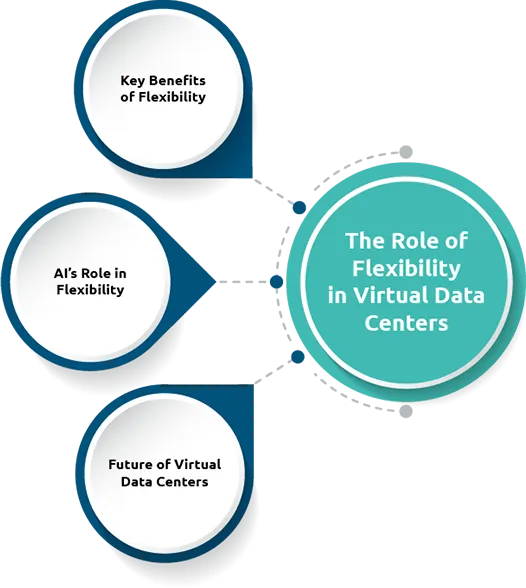In today’s world, data centers & data centers technology have a tremendous impact on the IT infrastructure. Cloud centers take the place of traditional data centers as these days data centers need to be large-scale and flexible for organizations. This transformation is made possible by the presence of a virtual data center within cloud computing, which is more flexible and cost-effective than traditional methods of data centers in the business world.

Understanding Scalability and Flexibility in Virtual Data Centers
Scalability
Scalability in cloud computing data centers allows business organizations to grow their IT resources with capacity without concern of compromising performance. It also maintains smooth running during peak traffic duration as well as the efficiency to increase or decrease depending on the traffic load. It also proves useful in terms of financial cost as it cuts on the infrastructure costs. The facility is highly reliable, making it suitable for firms in businesses that support variable traffic, such as the e-commerce and financial industries.
Flexibility
Flexibility in cloud computing allows IT environments to accept real-time needs without costly upgrades. Businesses can efficiently allocate resources, integrate new technologies & switch between cloud models smoothly. This flexibility ensures smooth workload management, improves performance, & supports innovation & scalability.
How Scalability Works in Virtual Data Centers
In the case of datacenters in the cloud computing environment, scalability is done in various manners. Vertical scaling in some quarters can also be referred to as scaling up which entails an upgrade of the current resources such as CPU, RAM & storage equipment to allow the handling of more tasks. It is mainly applied where more difficult application needs higher computational power in their operations. Vertical scaling is important in conforming high performance in a system without compromising on the fragments of the available resources, though the method has limitations concerning the actual physical capacity of the computer system.
The kind of scaling is the horizontal scaling also known as scaling out, which comprises adding more Virtual machines or containers to share the workload across different servers without interruptions. This is suitable for application that need High availability and redundancy because it improves system availability by load balancing across instances. The variation is based on the principles of cloud-native applications and microservices, allowing organizations to meet demand without overwhelming specific servers.
Autoscaling can be defined as the process of allocating or reallocating necessary computing resources either in terms of increase or decrease in needs during low or high traffic times respectively to avoid wastage of resources. Auto-scaling is a process of resource scaling where the business does not need to do it manually and can include more resources as per the required load. This comes in handy for situations where workloads are unpredictable as it allows smooth operations while avoiding the purchase of excess resources.
The Role of Flexibility in Virtual Data Centers
Flexibility in cloud computing data centers means that changes in design and the Components of the infrastructure can easily be made without necessarily having to close shop. One of the flexibility characteristics is the demand for resources where an organization can be able to demand resources based on the workload in the process. Businesses do not waste their resources as they can be allocated to the most important areas at the most necessary time. This real-time responsiveness helps manage IT costs as high performance and reliability is achieved simultaneously.
A major component of flexibility is the hybrid of private and public cloud data centres that create a continuous and versatile climate for IT. In particular, hybrid cloud solutions give organizations the benefits of a private cloud data center while accepting its features. It also makes sure that various task needs are handled in an efficient manner and that the organization complies with required security measures.
Extended cloud computing involves utilizing more than one cloud service provider, which boosts flexibility because cloud services from other suppliers are used to improve dependability, reliability & speed. Multi-cloud strategies help to avoid the domination of vendors, which stays beneficial for the organizations as they can use all those services that are the best for them. It is possible to ensure load distribution between many cloud providers to improve fault tolerance, service availability, as well as cost-effectiveness. There is also one more factor and that is flexibility, which is most closely related to software-defined infrastructure because software-defined networking and software-defined storage provide flexibility in the utilization of the resources. SDN and SDS deal with the abstraction of the hardware components out of control functions as this makes it easier to solve the issues of flexibility in the provision of resources. These technologies help in making the management of data centers flexible, automatic & less difficult.

The Impact of Virtualization on Scalability & Flexibility
Virtualization helps in the current domain of cloud computing data centers since it facilitates operation of many virtual machines on a given physical server. A process of creating virtual copies of physical resources nets the business better utilization of resources and improved productivity. It allows high performance since the amount of computing resources can be provided in line with the present needs.
One of its benefits is effective resource utilization since virtualization allows using IT resources most effectively and avoid their negative utilization. The other advantage is the cost saving of the infrastructure expenses because different works or functions can be hosted on many virtual machines. Speed is also another factor whereby virtualization accelerates the deployment of applications and other workloads in a way that would otherwise take a long duration to be achieved through traditional infrastructure.
Key Technologies Enabling Scalability & Flexibility
Automating the management of data center architecture is one of the significant aspects of the advancement of cloud computing through the application of artificial intelligence. Grok AI & similar predictive analytics technologies are useful when a failure occurs to prevent it from affecting operations. Forecasting tools allow the IT departments to identify such problems and respond before they require immediate attention. It is also useful in managing CPU, memory & storage resources effectively because of load balancing to avoid wastage of resources and cost. Apart from that, through the application of AI in data centers, Repetitive tasks are made automatic & the efficiency of the system is improved.
Conclusion
The innovation in data centers as well as cloud computing technology have revolutionized the geographical implementation of infrastructure solutions for Information Technology businesses. Today, business organizations that are using cloud-based data centers can control the workload along with the effective utilization of the resources and cost. With the fast advancement in the aspect of sustainability trends in data centers, there is a clear prediction that the future of the virtualized environment will be efficient, intelligent & fully under automation of artificial intelligence, where data centers virtual environment will be intelligent, adaptive and sustainable.








